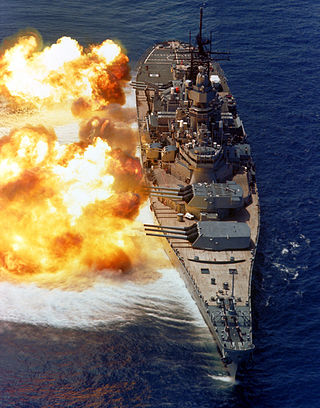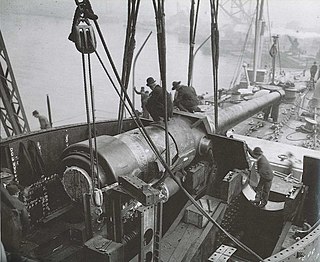
The 16"/50 caliber Mark 7 – United States Naval Gun is the main armament of the Iowa-class battleships and was the planned main armament of the canceled Montana-class battleship.

The New Mexico class was a class of three super-dreadnought battleships built for the United States Navy in the late 1910s. The class comprised three ships: New Mexico, the lead ship, Mississippi, and Idaho. Part of the standard series, they were in most respects copies of the Pennsylvania-class battleships that immediately preceded them, carrying over the same main battery arrangement of twelve 14-inch (356 mm) guns, but now increased to 50-caliber. They incorporated several other improvements, including a better arrangement of the secondary battery that increased its usability, a clipper bow that improved seakeeping, and an experimental turbo-electric propulsion system adopted on New Mexico. Like the other standard-type battleships, they had a top speed of 21 knots that allowed the fleet to operate as a tactically homogeneous unit.

The Colorado-class battleships were a group of four United States Navy super-dreadnoughts, the last of its pre-Treaty battleships. Designed during World War I, their construction overlapped the end of that conflict and continued in its immediate aftermath. Though all four keels were laid, only three ships entered service: Colorado, Maryland, and West Virginia. Washington was over 75% completed when she was canceled under the terms of the Washington Naval Treaty in 1922. As such, the 16" gun Colorado-class ships were the last and most powerful battleships built by the U.S. Navy until the North Carolina class entered service on the eve of World War II.

The Alaska-class were six large cruisers ordered before World War II for the United States Navy (USN), of which only two were completed and saw service late in the war. The USN designation for the ships of this class was 'large cruiser' (CB), a designation unique to the Alaska-class, and the majority of leading reference works consider them as such. However, various other works have alternately described these ships as battlecruisers despite the USN having never classified them as such, and having actively discouraged the use of the term in describing the class. The Alaskas were all named after territories or insular areas of the United States, signifying their intermediate status between larger battleships and smaller heavy and light cruisers.

The Florida-class battleships of the United States Navy comprised two ships: Florida and Utah. Launched in 1910 and 1909 respectively and commissioned in 1911, they were slightly larger than the preceding Delaware class design but were otherwise very similar. This was the first US battleship class in which all ships received steam turbine engines. In the previous Delaware-class, North Dakota received steam turbine propulsion as an experiment while Delaware retained triple-expansion engines.

USS Florida was an Arkansas-class monitor in the United States Navy.

The Pennsylvania class of six armored cruisers served in the United States Navy from 1905 to 1927. All six were renamed for cities 1912–1920, to make the state names available for the new battleships beginning with the Pennsylvania-class battleships. All of these served during World War I, with California being the only ship of the class to be lost. The remaining five armored cruisers were scrapped between 1930 and 1931 in accordance with the London Naval Treaty.

The first USS Nevada, a monitor, was ordered on 4 May 1898. She was awarded to the Bath Iron Works, Bath, Maine on 19 October 1898 and laid down as Connecticut, 17 April 1899. Connecticut was launched 24 November 1900; sponsored by Miss Grace Boutelle; renamed Nevada, January 1901; and commissioned on 5 March 1903, Commander Thomas B. Howard in command. The total cost for the hull, machinery, armor and armament was $1,851,313.22.

The 340mm/45 Modèle 1912 gun (13.4 in) was a heavy naval gun of the French Navy. While the calibres of the naval guns of the French Navy were usually very close to those of their British counterparts, the calibre of 340 mm is specific to the French Navy.

The 5"/25 caliber gun entered service as the standard heavy anti-aircraft (AA) gun for United States Washington Naval Treaty cruisers commissioned in the 1920s and 1930s. The goal of the 5"/25 design was to produce a heavy AA gun that was light enough to be rapidly trained manually. The gun was also mounted on pre-World War II battleships and aircraft carriers until replaced by the standard widespread dual-purpose 5"/38 caliber gun, which was derived from the 5"/25. Guns removed from battleships were probably converted for submarine use by late 1943, while a purpose-built variant for submarines was available in mid-1944, and was widely used by them. United States naval gun terminology indicates the gun fired a projectile 5 inches (127 mm) in diameter, and the barrel was 25 calibers long. It is referred to sometimes as a dual-purpose gun and sometimes as an anti-aircraft gun, because of its comparative weakness against surface targets.

The 14-inch/45-caliber gun,, whose variations were known initially as the Mark 1, 2, 3, and 5, and, when upgraded in the 1930s, were redesignated as the Mark 8, 9, 10, and 12. They were the first 14-inch (356 mm) guns to be employed by the United States Navy. The 14-inch/45-caliber guns were installed as the primary armament aboard all of the United States Navy's New York-class, Nevada-class, and Pennsylvania-class battleships. The gun also saw service in the British Royal Navy, where it was designated BL 14-inch gun Mk II.

The 12"/50 caliber gun Mark 8 was a US naval gun mounted on the Alaska-class cruiser. The gun, like the "large cruiser" that mounted it, was intended to fill the gap between US "heavy cruisers" (6-8") and US battleships (14-16"). The name describes the size of the shells, 12 inches in diameter, and the length of the bore in calibers.

The 12-inch/45-caliber Mark 5 gun was an American naval gun that first entered service in 1906. Initially designed for use with the Connecticut-class of pre-dreadnought battleships, the Mark 5 continued in service aboard the first generation of American dreadnoughts.

The 6"/53 caliber gun formed the main battery of some United States Navy light cruisers and three US submarines built during the 1920s.

The 16"/45-caliber Mark 6 gun is a naval gun designed in 1936 by the United States Navy for their Treaty battleships. It was introduced in 1941 aboard their North Carolina-class battleships, replacing the originally intended 14"/50-caliber Mark B guns and was also used for the follow-up South Dakota class. These battleships carried nine guns in three three-gun turrets. The gun was an improvement to the 16"/45-caliber Mark 5 guns used aboard the Colorado class, and the predecessor to the 16"/50-caliber Mark 7 gun used aboard the Iowa class.

The 12"/50 caliber Bethlehem gun was a US naval gun designed in 1910 as the main armament for the Argentine Navy's dreadnought battleships of the Rivadavia class.

The Arkansas-class monitors were the last class of four monitors ordered for the U.S. Navy.

The 16"/45 caliber gun was used for the main batteries of the last class of Standard-type battleships for the United States Navy, the Colorado-class. These guns promised twice the muzzle energy over the Mark 7 12-inch/50 caliber guns of the Wyoming-class battleship and a 50% increase over the 14-inch/45 caliber guns of the New York-class, Nevada-class, and Pennsylvania-class battleships.

The 152 mm /55 Model 1934–1936 were built for the Italian Navy in the years before World War II. These guns were used on the Duca degli Abruzzi-class Light cruisers, which were the final series of the Condottieri-class cruisers as their primary armament and as secondary armament on the Littorio-class battleships.




















